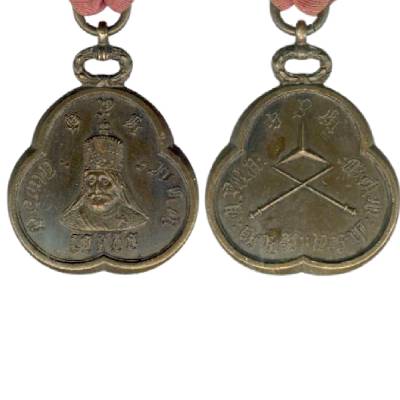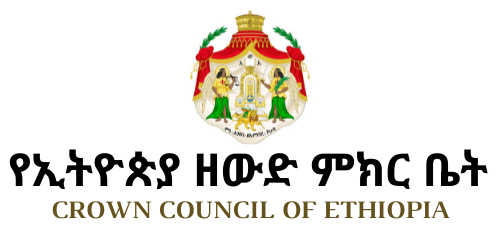
The Distinguished Military Medal of Haile Selassie the First, sometimes known as the Medal of Merit of Haile Selassie the First, was created by the Emperor during the campaign against the Italians who had overrun Ethiopia from October 3, 1935, to 1941. The decoration was presented to Ethiopians and, on rare occasions, to foreigners who fought in the campaigns for Ethiopia’s freedom. The medal was awarded for both single acts of extreme gallantry and for protracted military service of a distinguished nature.
The medal is bronze in the form of a trilobe, with the obverse showing a traditional portrait of Emperor Haile Selassie wearing the Ethiopian Crown, and with the inscription in Ge’ez “Haile Selassie the First”. The reverse has the three-pointed Star of the Trinity surmounting a pair of crossed batons, and the medal’s shape — like three overlapping circles — is designed to accommodate that. The 32mm wide riband is attached to the medal by a ring atop a horizontal oval laurel wreath. The riband itself is pale green in the top half and red in the lower half. A second award of the medal was signified by the addition of a palm leaf in bronze, placed horizontally across the riband where the red and green meet.
Emperor Haile Selassie wore the Distinguished Military Medal himself, ranking it sixth in order of precedence after the great State orders (Solomon’s Seal, the Queen of Sheba, the Holy Trinity, the Menelik II, and the Star), a real indication of the value of the DMM. His son, as Crown Prince Asfa Wossen, wore the DMM in eighth place on his riband bar.
The DMM continues to be a current decoration within the Imperial gift, although, at press time, the Crown Council had not authorised the striking of a new batch of the medal. It is understood that such a striking was being considered to recognise those Ethiopians who fought with great valour against the Dergue which overthrew Emperor Haile Selassie, while at the same time maintaining the fight for Ethiopian unity.
The medal was originally struck by Mappin & Webb, in London. Dennis Gill’s otherwise outstanding book on the coinage of Ethiopia shows the DMM without riband, incorrectly identifying it as “a bronze coronation medal” of Emperor Haile Selassie.1 Gill, Dennis: The Coinage of Ethiopia, Eritrea and Italian Somalia. Page 150. Holders of the medal may use the post-nominal initials DMM.


